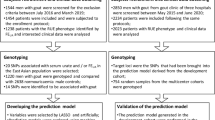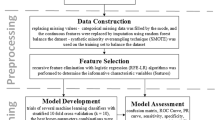Abstract
Purposes
Our aim is to build and evaluate models to screen for clinically significant nephrolithiasis in overweight and obesity populations using machine learning (ML) methodologies and simple health checkup clinical and urine parameters easily obtained in clinics.
Methods
We developed ML models to screen for clinically significant nephrolithiasis (kidney stone > 2 mm) in overweight and obese populations (body mass index, BMI ≥ 25 kg/m2) using gender, age, BMI, gout, diabetes mellitus, estimated glomerular filtration rate, bacteriuria, urine pH, urine red blood cell counts, and urine specific gravity. The data were collected from hospitals in Kaohsiung, Taiwan between 2012 and 2021.
Results
Of the 2928 subjects we enrolled, 1148 (39.21%) had clinically significant nephrolithiasis and 1780 (60.79%) did not. The testing dataset consisted of data collected from 574 subjects, 235 (40.94%) with clinically significant nephrolithiasis and 339 (59.06%) without. One model had a testing area under curve of 0.965 (95% CI, 0.9506–0.9794), a sensitivity of 0.860 (95% CI, 0.8152–0.9040), a specificity of 0.947 (95% CI, 0.9230–0.9708), a positive predictive value of 0.918 (95% CI, 0.8820–0.9544), and negative predictive value of 0.907 (95% CI, 0.8756–0.9371).
Conclusion
This ML-based model was found able to effectively distinguish the overweight and obese subjects with clinically significant nephrolithiasis from those without. We believe that such a model can serve as an easily accessible and reliable screening tool for nephrolithiasis in overweight and obesity populations and make possible early intervention such as lifestyle modifications and medication for prevention stone complications.

Similar content being viewed by others
Data availability
The datasets generated and/or analyzed during the current study are available from the first author or the corresponding author upon reasonable request.
References
Romero V, Akpinar H, Assimos DG (2010) Kidney stones: a global picture of prevalence, incidence, and associated risk factors. Rev Urol 12(2–3):e86
Ziemba JB, Matlaga BR (2017) Epidemiology and economics of nephrolithiasis. Investig Clin Urol 58(5):299–306
Pearle MS et al (2005) Urologic diseases in America project: urolithiasis. J Urol 173(3):848–857
Robson J et al (2016) The NHS health check in England: an evaluation of the first 4 years. BMJ Open 6(1):e008840
Smith-Bindman R et al (2014) Ultrasonography versus computed tomography for suspected nephrolithiasis. N Engl J Med 371(12):1100–1110
Ganesan V et al (2017) Accuracy of ultrasonography for renal stone detection and size determination: is it good enough for management decisions? BJU Int 119(3):464–469
Brisbane W, Bailey MR, Sorensen MD (2016) An overview of kidney stone imaging techniques. Nat Rev Urol 13(11):654–662
Kim S et al (2019) Metabolically healthy and unhealthy obesity phenotypes and risk of renal stone: a cohort study. Int J Obes 43(4):852–861
Chen H-W et al (2018) Mediators of the effects of gender on uric acid nephrolithiasis: a novel application of structural equation modeling. Sci Rep 8(1):6077
Chen Y-C et al (2019) Re: Can we predict the outcome of oral dissolution therapy for radiolucent renal calculi? A prospective study. J Urol 202(4):825–826
Chen H-W et al (2022) Prediction of the uric acid component in nephrolithiasis using simple clinical information about metabolic disorder and obesity: a machine learning-based model. Nutrients 14(9):1829
Taylor EN, Stampfer MJ, Curhan GC (2005) Diabetes mellitus and the risk of nephrolithiasis. Kidney Int 68(3):1230–1235
Rippel CA et al (2012) Residual fragments following ureteroscopic lithotripsy: incidence and predictors on postoperative computerized tomography. J Urol 188(6):2246–2251
Goodfellow I, Bengio Y, Courville A (2016) Deep learning. MIT press
Pedregosa F et al (2011) Scikit-learn: machine learning in Python. J Mach Learn Res 12:2825–2830
Kramer O (2016) Machine learning for evolution strategies. Vol. 20. Springer
Taylor EN, Stampfer MJ, Curhan GC (2005) Obesity, weight gain, and the risk of kidney stones. JAMA 293(4):455–462
Carbone A et al (2018) Obesity and kidney stone disease: a systematic review. Minerva Urologica e Nefrologica Italian J Urol Nephrol 70(4):393–400
Xu P, Wang J (2019) Number of metabolic syndrome components is the central predictor of the impact of metabolic syndrome on outcome of percutaneous nephrolithotomy in staghorn nephrolithiasis. J Endourol 33(11):946–953
Ishii H et al (2016) Outcomes of systematic review of ureteroscopy for stone disease in the obese and morbidly obese population. J Endourol 30(2):135–145
Chen TT et al (2015) Radiation exposure during the evaluation and management of nephrolithiasis. J Urol 194(4):878–885
Curhan GC et al (1993) A prospective study of dietary calcium and other nutrients and the risk of symptomatic kidney stones. N Engl J Med 328(12):833–838
Sorensen MD et al (2022) Removal of small, asymptomatic kidney stones and incidence of relapse. N Engl J Med 387(6):506–513
Rebuck DA et al (2011) The natural history of renal stone fragments following ureteroscopy. Urology 77(3):564–568
Worster A et al (2002) The accuracy of noncontrast helical computed tomography versus intravenous pyelography in the diagnosis of suspected acute urolithiasis: a meta-analysis. Ann Emerg Med 40(3):280–286
Ferraro PM et al (2020) Risk of kidney stones: influence of dietary factors, dietary patterns, and vegetarian–vegan diets. Nutrients 12(3):779
Sorokin I et al (2017) Epidemiology of stone disease across the world. World J Urol 35:1301–1320
Acknowledgments
This work was supported in part by the National Science and Technology Council of Taiwan (NSTC 111-2221-E-037-008, NSTC 111-2320-B-110-002), in part by the NSYSU-KMU joint research project (#NSYSUKMU 111-P09), and Kaohsiung Municipal Ta-Tung Hospital, Taiwan (kmtth-111-R009). The authors declare that there are no other conflicts of interest.
Author information
Authors and Affiliations
Contributions
HW Chen: Project development, Data Collection, Data analysis, Manuscript writing/editing. JT Lee: Project development, Data analysis, Manuscript writing/editing. PS Wei: Data Management, Data analysis, Manuscript editing. YC Chen: Data Collection, Manuscript editing. JY Wu: Data Collection. CI Lin: Data Collection. YH Chou: Data Collection. YS Juan: Data Collection. WJ Wu: Data Collection, Manuscript editing. CY Kao: Project development, Data Management, Data analysis, Manuscript writing/editing.
Corresponding author
Ethics declarations
Conflict of interest
The authors declare that there is no conflicts of interest.
Ethical standards
This is a retrospective cohort study based on past medical data; no human participants or animals were involved. The protocol for study was approved by the IRB at Kaohsiung Medical University Hospital (KMUHIRB-E(I)-20210331). The study was conducted following the principles set forth in the Declaration of Helsinki. The requirement for informed consent was waived because the study was retrospective by design and posed no risk to the subjects.
Additional information
Publisher's Note
Springer Nature remains neutral with regard to jurisdictional claims in published maps and institutional affiliations.
Supplementary Information
Below is the link to the electronic supplementary material.
Rights and permissions
Springer Nature or its licensor (e.g. a society or other partner) holds exclusive rights to this article under a publishing agreement with the author(s) or other rightsholder(s); author self-archiving of the accepted manuscript version of this article is solely governed by the terms of such publishing agreement and applicable law.
About this article
Cite this article
Chen, HW., Lee, JT., Wei, PS. et al. Machine learning models for screening clinically significant nephrolithiasis in overweight and obese populations. World J Urol 42, 128 (2024). https://doi.org/10.1007/s00345-024-04826-4
Received:
Accepted:
Published:
DOI: https://doi.org/10.1007/s00345-024-04826-4




